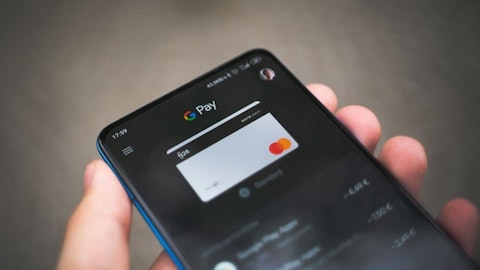Discover Financial Services (NYSE:DFS) Q2 2023 Earnings Call Transcript July 20, 2023
Operator: Good morning. My name is Todd, and I will be your conference operator today. At this time, I would like to welcome everyone to the Second Quarter 2023 Discover Financial Services Earnings Conference Call. All lines have been placed on mute to prevent any background noise. After the speakers’ remarks, there’ll be a question-and-answer session. [Operator Instructions] Thank you. I will now turn the call over to Mr. Eric Wasserstrom, Head of Investor Relations. Please go ahead.
Eric Wasserstrom: Thanks, Todd. And good morning, everyone. Welcome to this morning’s call. I’ll begin on Slide 2 of our earnings presentation, which you can find in financial section of our Investor Relations website investorrelations.discover.com. Our discussion today contains certain forward-looking statements that are subject to risks and uncertainties that may cause actual results to differ materially. Please refer to our notices regarding forward-looking statements that appear in our second quarter earnings release and presentation. On our call today, we’ll include remarks from our CEO, Roger Hochschild and, John Green, our Chief Financial Officer. After we conclude our formal comments, there will be time for a Q&A session. During the Q&A session, we ask that you pose one question followed by one follow-up question. After your follow-up question, please return to the queue. Now, it’s my pleasure to turn the call over to Roger.
Roger Hochschild: Thank you, Eric, and thanks to our listeners for joining today’s call. I’ll begin by reviewing some of our highlights for the quarter and then discuss the regulatory matter that we’ve disclosed in our press release. John will then take you through the details of our second quarter results and our updated perspectives on 2023. Last night, we reported second quarter net income of $901 million or $3.54 per share. The quarter was characterized by strong asset and deposit growth, while credit is performing right in line with our expectations. Importantly, we advanced several operational priorities this quarter. One key milestone occurred in May when we relaunched our cash back debit product. We’re excited by the positive early results we’re seeing so far.

Photo by Dylan Gillis on Unsplash
In the first few weeks, we opened over 30,000 new accounts and plan to begin national marketing in support of this product in the fall. The relaunch advances our goal of becoming the leading direct bank and over time we expect cash back debit will be a significant entry point into the Discover franchise. We also continue to expand the Discover Global Network. This quarter, we announced five new partnerships in the Asia Pacific region and added a new partnership with Guavapay in the UK. These strategic partnerships underscore our commitment to building out our international acceptance. And lastly, we continue to invest in our human capital. We’re honored to have been recognized as the 2023 Best Places to Work for People with Disabilities. This builds upon our recent recognitions as one of Fortune’s 100 Best Companies to Work For, Best Workplaces for Parents, and Best Workplaces for Women.
As you may have read in our press release last night, beginning around mid-2007, we incorrectly classified certain card accounts into our highest merchant and merchant acquirer pricing tier. We are taking actions correct this card product misclassification going forward and are preparing a program to compensate affected merchants and acquirers. While the financial impacts of this misclassification are not material, it underscored deficiencies in our corporate governance and risk management. We’re in discussions with our regulators regarding these matters. We have received a proposed consent order from the FDIC in connection with consumer compliance, which does not cover the misclassification topic. We believe additional supervisory actions could occur.
I want to emphasize that we take our business practices and compliance very seriously. We’ve made significant progress and investment in this area and look forward to working with our Board and our regulators to achieve further advancement. Now I’ll hand it over to John to review our results and updated outlook in more detail.
John Greene: Thank you, Roger, and good morning, everyone. I’m going to open by addressing the financial implications of the card misclassification. We have established a liability on our balance sheet of $365 million to accrue for estimated compensation owed to merchant and acquirers. In establishing the liability, we adjusted retained earnings by $255 million net of tax. $11 million was taken this quarter and is reflected in discount and interchange revenue. The first half 2023 impact was $22 million. With that, I’ll transition to our financial summary results on Slide 4. From this, you can see that the financial performance of the business remains solid. In the quarter, we reported net income of $901 million, which was 18% lower year-over-year.
Our results reflect strong revenue growth partially offset by a provision increase driven by receivable growth and higher expenses. The trends for the quarter were robust loan growth, a low efficiency ratio even as we invested in compliance management and technology, and strong capital and liquidity positions. Further details are reflected on Slide 5. Net interest income was up $567 million year-over-year or 22%. Our net interest margin ended the quarter at 11.06%, up 12 basis points from the prior year and down 28 basis points sequentially. The benefits from higher prime rates were offset by higher funding costs and increased promotional balances. Receivable growth was robust. Card increased 19% year-over-year, reflecting a lower payment rate versus the prior year and modest sales growth.
The card payment rate remains stable quarter-over-quarter and about 200 basis points over 2019 levels. Sales volume grew 3% in the quarter. Through mid-July, growth continued to slow and was up about 1%. Turning to our non-card products. Personal loans were up 27% driven by strength in originations over the past year. We continue to experience strong consumer demand while staying disciplined in our underwriting. Deposit growth in the quarter was solid, with average consumer deposits up 20% year-over-year and 4% sequentially. Our direct-to-consumer balances grew $2 billion and consumer deposits made up 66% of our total funding mix. We continue to target 70-plus-percent of funding from deposits. Looking at other revenue on Slide 6. Non-interest income increased $98 million or 16%.
This was partially due to a $42 million loss on our equity investments in the prior year quarter compared to a $1 million gain this quarter. Adjusting for these, our non-interest income was up 9%, primarily driven by loan fee income. Moving to expenses on Slide 7. Total operating expenses were up $181 million or 15% year-over-year and up 2% from the prior quarter, primarily driven by our investments in our compliance management systems. These investments impacted several of our expense line items. Looking at our major expense categories, compensation costs were up $73 million or 14%, primarily due to increased headcount. Marketing expense increased $14 million or 6% as we prudently invested for growth, particularly in our deposits and personal loan products.
Our commitment to disciplined cost management has not changed and we continue to target an efficiency ratio in the high 30s. Moving to credit performance on Slide 8. Total net charge-offs were 3.22%, 142 basis points higher than the prior year and up 50 basis points from the prior quarter. Consistent with our expectation, we are seeing credit normalization across all of our lending products. Looking ahead in card, we continue to expect the seasoning of new accounts vintages and normalization of older vintages to result in higher losses through the back half of this year and into 2024. Turning to the allowance for credit losses on Slide 9. This quarter, we increased our reserve by $373 million, driven by our double-digit loan growth. Our reserve rate remained flat at 6.8%.
Our outlook on the macro economy has improved modestly. We continue to monitor economic conditions and will make adjustments to our expectations as needed. Looking at slide 10, our capital position remains robust. Our common equity Tier 1 for the period was 11.7%, well ahead of regulatory requirements. The cumulative impact of the correction to the financial statements related to the card misclassification reduced our CET1 ratio by approximately 20 basis points. In the quarter, we repurchased 6.8 million shares of common stock and declared a quarterly common dividend of $0.70 per share. As Roger indicated, we are reviewing our compliance, risk management and corporate governance and are in discussions with our regulators on these topics. While this is ongoing, we have decided to pause share repurchases.
Concluding on Slide 11 with our outlook. There has been no change to our loan growth expectations to be in the low to mid-teens. We are updating our NIM expectations to be around 11% for the full year, reflecting a combination of slightly lower asset yields driven by promotional mix and higher funding costs. We are raising our guidance for operating expenses to be up low double digits. As previously indicated, we are seeing upward pressure on expenses from the build-out of our compliance management systems. And we are lowering our expected range of net charge-offs to 3.4% to 3.6% based on our current delinquencies and roll rates. To wrap up, our business model continues to generate solid financial results and our capital, funding and liquidity positions remain strong.
We continue to invest in actions that drive sustainable long-term performance, enable us to achieve excellence in all parts of our business. With that, I’ll turn the call back to our operator, Todd, to open the line for Q&A.
See also 20 Countries With Highest Rate Of Down Syndrome and 25 Poorest States in America.
Q&A Session
Follow Discover Financial Services (NYSE:DFS)
Follow Discover Financial Services (NYSE:DFS)
Operator: Thank you. At this time, we will open the floor for questions. [Operator Instructions] We’ll take our first question from Rick Shane of JPMorgan. Please go ahead.
Rick Shane: Thanks guys for taking my questions this morning. Look, I’d love to understand a little bit the link between what you identified in terms of the miscalculation and then how that precipitated the sort of inquiry into governance and consumer tracking?
Roger Hochschild: Sure. So the FDIC matter is not linked to the misclassification. And so the misclassification is a separate issue. The FDIC matter is broadly around our compliance management system. It doesn’t mean that the misclassification may not result in further regulatory action, but I don’t want to speculate on that.
Rick Shane: Got it. And is the expectation, when we’ve seen these in the past that they result in things like memorandum of understanding and can do things like either constrain growth limit, repurchases and capital actions, how do you see this playing out? And most importantly, I think what everybody really wants to know is what is a reasonable timeframe to get some further clarity here?
Roger Hochschild: Yeah, it’s — I don’t want to speculate on the timeframe of regulatory actions. I would say to your point though, they can take many forms. And so we’re working through the draft with our regulators and we’ll make more information available and the consent order will itself be public once that’s completed.
Rick Shane: Got it. Okay. I realized there’s — you have to be pretty circumspect about what you say here. So, thank you.
Roger Hochschild: Thanks.
Operator: Thank you. We’ll take our next question from Betsy Graseck with Morgan Stanley.
Jeff Adelson: Yeah, hi, thanks. This is Jeff Adelson on for Betsy. Just appreciate all the sensitivity around this and understand you’re pausing the buyback. I guess, this is — this is some similar to what we saw last year in terms of regulatory issue and getting ahead of the buyback or freezing the buyback. Just wondering maybe if there’s a way to speak to how these two issues kind of compare to the last year student loan servicing issue, maybe in terms of scoping complexity?
Roger Hochschild: Yeah. I’ll cover that piece and then maybe John can talk a bit about the buyback. So I would say the consent order in student loan servicing was a compliance matter. And so I think there’s a link between that and the broader focus on our compliance management system. With that, maybe I’ll let John talk a bit about the buyback.
John Greene: Great. And — thanks Roger. And as it relates to the buyback, we had robust conversations internally whether or not to pause the buyback. And what management recommended to the Board was that we pause the buyback as we work through the details of these compliance and risk management issues and are in conversations with our regulators. I want to reiterate the following though. Our capital allocation priorities remain consistent. So first invest in the business and growth and certainly through this year and into next year into compliance and risk management. And second, the priority will be to return excess capital to shareholders. So no change in terms of the two primary capital allocation priorities. I also want to focus your attention onto the strong capital generation that the business delivered in the quarter and has delivered historically.
So we’re hoping that we kind of work through these issues in an expedited fashion, but timing, I can’t be specific on. So with that, the buyback will provide us much clarity on the timing of resumption when we have information on that.
Jeff Adelson: Okay. Thank you. And just maybe shifting gears a bit here. Just wanted to see if we could get an update on what you’re seeing in the consumer in your book today. Could you maybe also give us an update on the spend trajectory you’ve been seeing so far in July? I know you’ve talked about the growth rate slowing down to 3% in recent months. Wondering if we’re seeing something similar from here?





